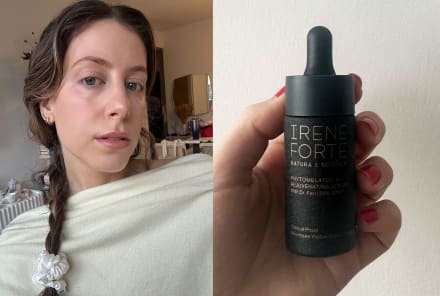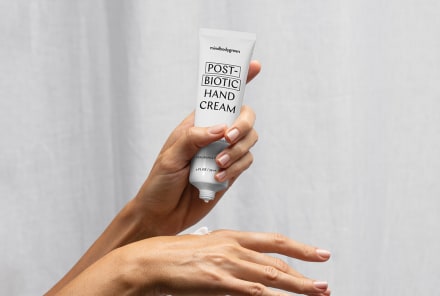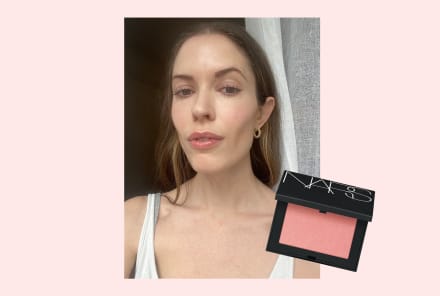Advertisement
13 Dark Spot Remedies You Can Find In Your Kitchen


Whether left behind from acne, brought on from age or from sun exposure, stubborn dark spots—also known as hyperpigmentation—are the bane of makeup-free complexions. Treatment for hyperpigmentation typically calls for three main avenues: prevention, fading, and gradual removal. Luckily, there are several natural ingredients that can be found in our kitchens to tackle hyperpigmentation on the spot. Pun intended.
Aloe vera
Aloe vera has been an anecdotal skin care savior for quite some time. The skin-healing properties come from the healthy chemical makeup, which includes vitamins, enzymes, minerals, salicylic acids, and amino acids1. A recent study review found that aloe vera juice also has aloesin2, which may help heal acne-related hyperpigmentation when applied topically.
Try it at home:
Simply apply the gel to the skin as a spot treatment or mask. If you want more specific ideas, we have a thorough aloe vera DIY mask guide here.
Indian gooseberry
"Amla fruit [also called indian gooseberry] extract is an ultra-potent source of vitamin C and other antioxidant compounds," says Michelle Hure, skin care expert at OC Skin Lab. "It inhibits melanin pigment by blocking [the] pigmentation pathway, making it comparable to hydroquinone—without the same risks or side effects." Worth noting: Studies back up the photo-damage claims3. Furthermore, studies also reveal it also inhibits bacterial growth, aids in wound healing, and promotes collagen production. (Yes, please.)
Try it at home:
It's easy to use, too. Simply take the powder, mix it with water, and use it as a gentle face scrub once a week. Not only are you getting the antioxidants, but you're getting a light physical exfoliation too.
Lemon, grapefruit, oranges, kiwi, yuzu, or plum
Board-certified dermatologist Lily Talakoub, M.D., of McLean Dermatology & Skincare Center points out that these tasty fruits are all packed with ascorbic acid, a naturally occurring form of vitamin C. The antioxidant is popular for brightening complexions and fading spots because it addresses both prevention and fading while also mitigating the damage of environmental causes such as sun damage. It even expedites the healing of scars.
Try it at home:
Simply dab a bit of lemon juice directly onto the dark spot. Bear in mind, however, that citrus juice can result in significant photosensitivity, something that will make UV-aging and dark spots worse. Be sure to never apply it directly before going into the sun. And even then, remember to wear a hat, slather on the safe SPF.
Tomatoes
The body converts the antioxidant beta-carotene, found in red-orange fruits and vegetables, into vitamin A—the natural form of retinol. As Morgan Rabach, M.D., boar-certified dermatologist and co-founder of LM Medical, explains, the active ingredient exfoliates away pigmented cells on the surface of the skin, while it simultaneously stalls skin-darkening melanin from forming deeper pathways in the skin. While gentler than its prescription form, Rabach warns that natural sources of retinol, like carrot oil, will never be as potent as its clinical counterpart. Still, if you're interested in a healthy aging, collagen-boosting pick that smooths fine lines and wrinkles, vitamin-A-rich ingredients are a solid choice. Plus, it’s rich in carotenoids, particularly β-carotene and lycopene, tomatoes also pack a punch for UV protection and skin cancer prevention4. (Not an excuse to skip SPF, however.)
Try it at home:
For your DIY method: Try pureeing fresh, organic tomatoes into a paste for a mask. Apply it to clean skin, leave it on for 5-10 minutes, and rinse with luke warm water. Continue with your skin care routine as normal.
Kombucha
It turns out that fermented tea, or kombucha, improves helps improve your complexion. The probiotic-packed, antioxidant powerhouse brightens and evens skin tone in two ways. First, the anti-inflammatory effect of the elixir's components5 can help to prevent inflammatory scarring resulting from skin irritants, as well as acne and eczema. Secondly, it contains a compound that boosts collagen production6, generating new, unpigmented skin cells more quickly. Keep in mind, however, that the most effective skin care formulations are not the same as our drinkable beverages.
Try it at home:
Kombucha makes an effective toner: Apply it with a pad post-face-wash.
Apple cider vinegar
Apple cider vinegar is one of the most popular DIY beauty remedies. To start, the antibacterial and antimicrobial properties of apple cider vinegar help to prevent breakouts while its anti-inflammatory effects reduce the risk of scarring. But ACV also contains malic acid, an exfoliating alpha-hydroxy acid that removes dead skin cells marred by pigmentation. Used as a spot treatment or toner, this can result in a brighter, more even skin tone. Before using apple cider vinegar, remember that AHAs result in sun sensitivity and to always dilute it with water before applying directly to skin.
Try it at home:
If you are interested in using this to tend to acne or dark spots, read our guide to ACV toners here.
Licorice extract
"Licorice root extract comes from the root of a legume plant and contains several antioxidant compounds, with Glabridin being the main agent," states Hure. "While licorice root hasn't been well studied as a depigmenting agent, it is very promising as a daily adjunct to sunscreen to prevent UV and post-inflammatory pigmentation." This study identifies licorice root extract as both a tyrosinase inhibitor and a melanogenesis inhibitor7, which—more simply—means that the root extract can help prevent the development and worsening of dark spots over time.
Try it at home:
Brew up some licorice root tea, let it steep and cool. Then you can dab on the tea bag onto dark spots for an easy, quick spot treatment.
Dried cranberry leaves, blueberry, bearberry, pear trees, pear skin
Arbutin is the plant-derived form of hydroquinone8, one of the most-cited hyperpigmentation treatments in skin care. However, these are more natural versions to its prescription counterpart, if you are one to default to all-natural. Like licorice root extract, it works by inhibiting tyrosinase7, the primary enzyme responsible for the formation of melanin in the skin. Hure shares that Arbutin can be effective but that it is less so than kojic acid and that a couple of caveats exist. "Higher concentrations of Arbutin can actually cause hyperpigmentation," she begins. "Studies show that the synthetic form, Deoxyarbutin9, is a much more potent lightening agent and antioxidant [that is] on par with hydroquinone—and considerably safer." Read: Maybe try a store-bought formulation for this one.
Try it at home:
While you'll be better off reaping the benefits of arbutin in a store-bought version, you can make a fun blueberry mask regardless. It won't be as potent, but you can do it right at home. Check out some DIY berry masks here.
9. Horseradish
Naturally high in vitamin C and antioxidants, horseradish has healing properties that have been shared anecdotally in traditional Chinese medicine for ages. Due to its antioxidant content, studies have shown it to be an effective anti-inflammatory10, too, which can help with post-inflammatory hyperpigmentation especially.
Try it at home:
Most suggest mixing horseradish powder with another brightening agent—most often you hear apple cider vinegar—to make it more potent.
10. Papaya
Papain is a protein-consuming enzyme found in unripe papaya that aids in the healing of raised scars11 when applied topically to the skin, making the active especially promising in cases of post-inflammatory pigmentation, scarring, and uneven skin texture. "When used topically, papain breaks down the bonds between cells on the outer layer of the skin, thereby exfoliating them off," explains Hure. She warns, however, that studies have shown that it can have inflammatory and irritating effects on the skin12.
Try it at home:
Blend papaya into a thick puree (you can add honey to make the consistency stickier so it applies to skin better) and apply to clean skin. Rinse off after 10 minutes.
11. Sake
Thanks to the fermentation process that transforms rice into wine, sake possesses a natural compound called kojic acid13, an ingredient with clinically verified, skin-brightening effects. NYC-based plastic surgeon Melissa Doft says that kojic acid decreases the melanin in the skin, thereby lightening spots and evening out your overall skin tone. As an added benefit, sake skin care products are lauded for their ability to improve skin texture and hydrate, to boot.
Try it at home:
Use this as a toner much like you might kombucha: Just apply to skin post wash with a cotton pad, let it sink in, and continue with serums and moisturizers.
12. Organic unsweetened yogurt
Yogurt's probiotics are beneficial for the skin's microbiome, while the gentle exfoliant, lactic acid, helps to even skin tone. "Lactic acid helps by exfoliating dead skin cells, leaving a more evened-out skin tone," Rabach says.
Try it at home:
It's great for whipping up a DIY mask with some honey, berries, or even a capsule of probiotics. Always opt for organic, unflavored yogurt, which will help minimize exposure to processed sugar.
13. Raspberries, strawberries, and cherries
Alpha-hydroxy acids14—including glycolic, citric, lactic, malic, and tartaric acids—can be found in berries along with a heaping dose of free-radical-fighting antioxidants. They are fantastic brightening agents for their small molecule size and deep penetration, sloughing off thousands of surface-level cells and cuing the body to begin repair without causing inflammation. With regular use, you can expect smooth, clear, more even skin tone. However, it is important to remember that these tingling agents can be irritating to the skin, and should only be used with caution along with your other exfoliating ingredients.
Try it at home:
Puree into a DIY scrub by tossing in you favorite fruits into a blender. Once you've made your goop, slather it on your face working in small, circular motions. Rinse off after.
14 Sources
- https://www.ncbi.nlm.nih.gov/pmc/articles/PMC2763764/
- https://www.ncbi.nlm.nih.gov/pmc/articles/PMC5843359/
- https://www.ncbi.nlm.nih.gov/pubmed/20688142
- https://www.ncbi.nlm.nih.gov/pubmed/31370257
- https://www.sciencedirect.com/science/article/pii/S1047279718307385
- https://www.ncbi.nlm.nih.gov/pubmed/29152918
- https://www.ncbi.nlm.nih.gov/pmc/articles/PMC2801997/
- https://www.ncbi.nlm.nih.gov/pubmed/18045355
- https://www.ncbi.nlm.nih.gov/pubmed/?term=deoxyarbutin+and+skin+pigmentation
- https://www.ncbi.nlm.nih.gov/pubmed/26411988
- https://www.ncbi.nlm.nih.gov/pubmed/28040601
- https://www.ncbi.nlm.nih.gov/pmc/articles/PMC3523510/
- https://www.ncbi.nlm.nih.gov/pubmed/31269882
- https://www.ncbi.nlm.nih.gov/pmc/articles/PMC6017965/
Watch Next
Enjoy some of our favorite clips from classes
Enjoy some of our favorite clips from classes
What Is Meditation?
Mindfulness/Spirituality | Light Watkins
Box Breathing
Mindfulness/Spirituality | Gwen Dittmar
What Breathwork Can Address
Mindfulness/Spirituality | Gwen Dittmar
The 8 Limbs of Yoga - What is Asana?
Yoga | Caley Alyssa
Two Standing Postures to Open Up Tight Hips
Yoga | Caley Alyssa
How Plants Can Optimize Athletic Performance
Nutrition | Rich Roll
What to Eat Before a Workout
Nutrition | Rich Roll
How Ayurveda Helps Us Navigate Modern Life
Nutrition | Sahara Rose
Messages About Love & Relationships
Love & Relationships | Esther Perel
Love Languages
Love & Relationships | Esther Perel

















